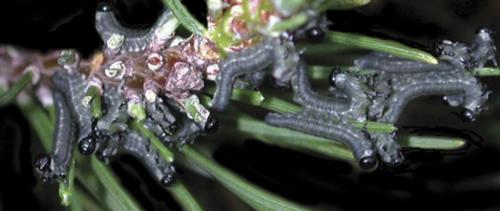The mystery of missing pine needles: European pine sawfly
European pine sawfly larvae are a likely suspect when pines have missing second year needles.

By this time of year, when you look at some pine species in the landscape, you may observe that the second year needles are curiously absent, with only short stubs left where clusters of needles once were present. The culprits may already be gone, or moved on to a different branch. Damage becomes more noticeable after the new growth has emerged. What caused the damage? The answer is most likely European pine sawfly larvae. They have a taste for pine needles, and like to feed in groups, stripping away all the second year needles on a branch, before they move as a group to a new branch. Their favored hosts are Scots, mugho, red, Japanese red, jack and Swiss mountain pines. Eastern white pine and Austrian pine are also occasionally damaged.

Pine sawfly larvae feed as a group and consume all the second year needles on a branch before moving to a new branch to feed. Photo: Diane Brown, MSU Extension
Pine sawfly larvae are grayish-green with several lighter green and black longitudinal stripes and black heads. They resemble caterpillars, but are actually stingless relatives of wasps, not butterflies or moths. They are about an inch long when fully grown. After the larvae mature, they drop to the ground, pupate in the soil and emerge as adults in September and October to mate and lay eggs. Female sawflies make slits in the current year’s needles to lay eggs. The eggs remain protected inside the needles until the larvae hatch the following spring. Young larvae are actively feeding by the time redbud trees begin to bloom (mid-May this year). European pine sawfly feeding can result in cosmetic damage to landscape or specimen plantings of pines, but rarely causes serious injury. Young larvae can be removed with a forceful stream of water or killed with insecticidal soap. Older larvae can be pruned out along with damaged branches or removed by hand.



 Print
Print Email
Email


